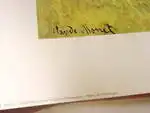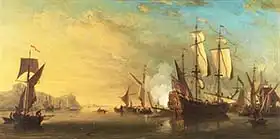About this finishing
Print. The image is printed on the top quality 10-ink HP Z9PS printer on HP matte 270 g / m2 paper. You can choose any size to an accuracy of 1 cm. A margin of 5 cm around the image is added to the size of the motif.


You can find a detailed description about our finishings
here.
Sailing from Dover
Date:
1742"The Embarkation of the Troops at Dover" is an oil painting by the English painter
Samuel Scott . This painting was created in 1754 and depicts the historical event of British troops leaving the port of Dover as part of an expedition known as "The Year 1742" during the Wars of the Austrian Succession.
The painting shows the busy port of Dover, which is full of
warships , soldiers, and civilians. Soldiers are about to be loaded onto ships and set off to battle. A calm channel with waves and a few distant ships can be seen in the background of the painting. This creates a contrast between the calm of the sea and the hustle and bustle of the shore. Samuel Scott focused on the details of the ship, the uniforms of the soldiers and the busy happenings of the port, which gives the image a vividness and authenticity.
The color palette of the painting is realistic, with the use of natural colors and lighting effects that create the impression of depth and movement. The painting captures the period clothing and equipment of the soldiers, which contributes to the historical authenticity of the painting.
This painting is an important work in the development of 18th century English painting and is valued both for its historical significance and its artistic quality. "Sailing from Dover" by Samuel Scott is an important depiction of military action of the time and has long been exhibited in various museums and galleries in the United Kingdom.
Scott painted picture Sailing from Dover in 1742. Prevailing color of this fine art print is brown and its shape is long. This image is printed on demand - you can choose material, size and finishing.
Samuel Scott (1702-1772) was a British
Classicist landscape painter, mostly focusing on water themes. Born in London, he began as an artist, painting boats -
Departure from Dover -on differently behaving seas. Along with George Lambert, he drew a six-part series of paintings for the East India Company. From 1740, Scott worked on paintings overlooking
Westminster. Although he worked primarily with oil, many of his works were painted in watercolours, for which he later earned the nickname the father of English watercolour. The peak of his fame came with the paintings of coastal and marine scenes with not only military ships -
Sailing on Stormy Seas.


